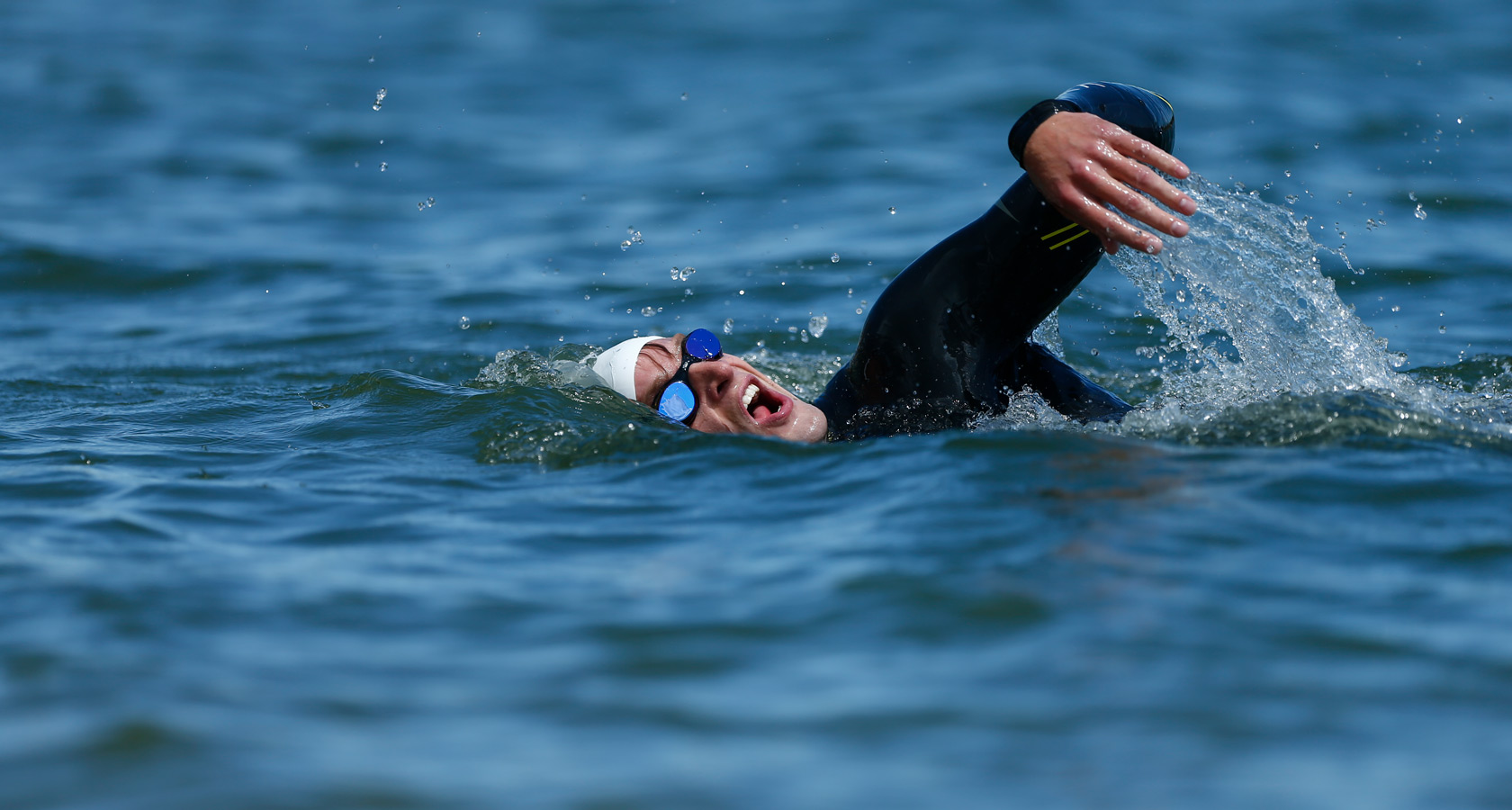Photo Credit - Jack Dempsey
Plan Your Open Water Swim Training
Just as you need to have a solid plan for your workouts in the pool (warm-up, drills, main sets, cooldown), you need to have a plan for your open water swims as well. Yes, you can simply wade into the water with your local triathlon club for the weekly open water swim and get in your LSD (long, slow distance) swim for the week. That works once in a while. But in reality, you should have a workout plan that's equally as structured as your pool workouts to maximize your time and to get the most out of your workout.
To that point, you need to have a goal for the workout at hand. Is it to get in a certain distance? Is it to work on sighting and deal with water currents? Depending on the conditions at hand, you may need to alter your plan, but you need to show up with your goals clearly defined and understand exactly what you want to achieve from your workout. There's nothing wrong with needing to get in a swim for time. Knowing that you want to swim 30-45 minutes at a certain perceived effort is perfectly fine (and is something that you'll indeed need to do). But you should have some solid workouts and sets in your arsenal to ensure you maximize your open water time.
Warm-Up
The same way you need to warm up before starting your main sets in the pool, you need to do the same for open water swims. Depending on the location, you may have swim zone buoys showing the demarcation of the swim zone to boat traffic. A typical warm-up for my club is to swim out to the first buoy, regroup, and then swim easy for two buoys. We regroup and repeat. We'll do this for one full "length" of the swim zone. In our case this gives us approximately 10 minutes of swimming to get loose and comfortable. If you don't have swim marker buoys to use for this purpose, simply swim easy for 2-3 minutes. Stop, regroup and repeat.
It's easiest and safest to swim parallel to the shore. If there's no discernible swim zone to work with, simply find a couple of landmarks to use as the two ends of your length. Then, head out from shore far enough to provide a depth level that allows easy swimming. Swimming straight out away from shore and then turning around after a period of time, puts you at risk of entering into boat traffic or shipping zones (depending on the body of water). It's best to stay close to shore.
Once your warm-up is done and you're loose and ready to begin your workout, there are numerous drills and sets that you can work into your open water swim. Variety is the spice of life — doing the same workout over and over again paves the way for boring open water swims (or any workout for that matter). Change up your routine to keep your workouts fresh and interesting.
Speed Drills
Your open water workout should not only include proper time to warm up, but you should also on occasion include some speed work into your plan — similar to what you would do when you're in the pool. After your warm-up you'll alternate between swimming at a steady state and increasing your pace to something just under your race pace. Perhaps Zone 4 on a scale of perceived effort. Hold this for 45 seconds to a minute. Then ease up and swim steady for a minute. Repeat 8-10 times. You can shake this drill up a bit by going hard for a certain number of strokes. Swim hard for 50 strokes and then swim easy for 50 strokes.
You can also do these repeats at a higher intensity. They'll be for a shorter duration and may require a little more rest in between to ensure that you maintain your form. If you need to tread water in between each effort that's fine. You want to make sure you get enough rest between each repeat so you can maintain good form while holding the intensity.
Stroke Drills
You can still do stroke work when you're not in the pool. And you should always ensure that you build in some time during your workout to focus on your stroke. During your warm-up include some of the same drills that you would do when in the pool. You don't need to go crazy here, but it's good to work on your form — especially when you're in a full-sleeve wetsuit and your feel of the water will be a quite different. Some great stroke drills to consider:
Fist swim: Exactly the same drill as done in the pool. Swim for a set amount of time or a set number of strokes with your hands balled into fists. This will force you to "feel" the water and to ensure a proper catch phase as well as becoming more aware of your hand and arm positions.
Single-arm swim: This is a great way to connect your hips to your shoulders during your stroke. With your left arm extended, swim 10-15 strokes with your right arm. Then switch.
Swimming with a 'pause': This drill will ensure a quick and strong finish of your stroke under water. During your recovery phase, when your hand is right about at your armpit, pause your stroke for a full second before continuing on and finishing your recovery as well as underwater stroke. You'll need to alternate the sides you breathe on to work both arms on this drill. You'll breathe on the opposite side of your "paused" arm.
Sighting
This is perhaps the most important skill to ensure success in the swim leg of any triathlon, and you can practice this in the pool before you get into the open water. While you need to practice this as part of your swimming routine, it's something that you'll be doing constantly. The question is how much sighting do you need to do and how straight can you train yourself to swim?
Back in my days of high school and collegiate swimming, we'd do a drill called Tarzan. We swam with our head out of the water as we focused on our above water arm recovery. For our purposes here, lifting your head slightly out the water for 1-2 strokes will suffice. Focus on the pace clock, a starting block, any easy target to pick out. Pick your head up just enough to not only put your eyes on your sighting target, but to also get a breath. Don't focus on raising your shoulders for this drill — focus on raising your head. Repeat this once or twice every length as you warm up or cool down for 100-200 yards. You don't need to do this every time you're in the pool, but if you feel you need to work on this skill, integrate this into at least one pool workout per week.
In the open water, however, you'll need to find landmarks to keep you in a straight line. The old adage holds true — don't assume the person in front of you is swimming on target. In a race, you may have found someone who's swimming your pace and you're psyched that you can draft off this person. But if they're swimming off course, you risk following them and losing valuable time. The easiest objects to sight off during a race are the orange buoys or course markers. But during your open water workout, you'll need to use something else. A house. A large tree. Anything that's easy to target to keep you on track.
Every 10-12 strokes, pick you head up (just as you practiced in the pool) and find your landmark. If you find you need to sight more often, do so. Eventually, with practice, you'll become better at sighting and you'll find the need to pick your head up to be less frequent.
When heading in to the beach — whether in a race or at the end of a workout — you'll most likely need to find a landmark to assist you as well. It's all too easy in a race to "follow the crowd" after the last swim buoy, but this again may not ensure the best route. Before you start out in your workout or race, find a landmark near the swim exit and use that to guide you home after the last turn.
Bilateral Breathing
Breathing on alternating sides can help keep you on a straight course as well as ensuring that in rougher water you can breathe opposite the side that waves might be approaching from. Additionally, what if the swim buoys are on the opposite side that you normally breathe on? If you're not comfortable bilateral breathing, work this skill into your pool workouts. It's easier to practice this skill in the pool than it is in the open water.
Start Drills
Since most triathlons incorporate a beach start for the swim, it's important to practice your start and entry into the water. Starting on the beach, run into the water until it's approaching knee height. Then continue your running with a high-knee run. This will only last for a few moments until the water reaches your knees and above. At this point you may opt to dolphin dive a few times before you begin swimming. Swim hard for 15-30 seconds, turn around and swim easy back to shore. Repeat 5-6 times. This is best done with a group, if possible, to simulate a mass start.
Now to state the obvious: Always swim with a partner — a group is better. You need to keep an eye on each other and ensure that nobody is in distress or requires assistance. Never swim an open water workout alone. Ideally, if this is a group or triathlon club workout, you should have kayak support and spotters on the beach or shore. It's also important to note that open water swimming in a lake is quite different than swimming in an ocean. Currents will be much more severe and unpredictable in the ocean. Obvious statement? Perhaps. But it’s worth mentioning. And remember, you'll need to take the current into consideration when sighting.
I'm really just scratching the surface here. There are numerous other drills, theories and workouts that can be incorporated into both your open water and pool workouts. Should you have questions, need advice or feel that you need additional assistance to become more comfortable in the open water, you should reach out to any USA Triathlon Certified Coach for assistance.


